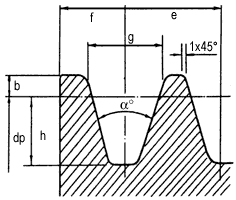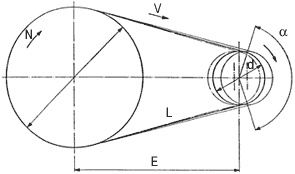H
To DIN2211 (ISO 4183)

| TYPE | DP (mm) |
alpha?/B> | f | E | g | h | b |
| SPZ | < 80 | 34 | 8,00 | 12,00 | 9,7 | 9 | 2,00 |
| > 80 | 38 | 8,00 | 12,00 | 9,9 | 9 | 2,00 | |
| SPA | < 118 | 34 | 10,00 | 15,00 | 12,7 | 11 | 2,75 |
| > 118 | 38 | 10,00 | 15,00 | 12,9 | 11 | 2,75 | |
| SPB | < 190 | 34 | 12,50 | 19,00 | 16,1 | 14 | 3,50 |
| > 190 | 38 | 12,50 | 19,00 | 16,4 | 14 | 3,50 | |
| SPC | < 315 | 34 | 17,00 | 25,50 | 21,9 | 19 | 4,80 |
| > 315 | 38 | 17,00 | 25,50 | 22,3 | 19 | 4,80 |
SERVICES FACTORS |
CONDITIONS OF OPERATION | ||||||||
8 hours per day |
16 hours per day |
24 hours per day | |||||||
uniform torque |
variable torque |
highly variable torque |
uniform torque |
variable torque |
highly variable torque |
uniform torque |
variable torque |
highly variable torque | |
| Normal electric motor (Cd/Cn) <=2 | 1 | 1.12 | 1.25 | 1.12 | 1.25 | 1.40 | 1.18 | 1.32 | 1.50 |
| Freqent start/stops or rsing | 1.18 | 1.25 | 1.40 | 1.25 | 1.40 | 1.60 | 1.32 | 1.40 | 1.70 |
| Electric motor with a high startup torque, or motor asynchronous, single or twin cylinder diesel engine | 1.18 | 1.32 | 1.50 | 1.32 | 1.50 | 1.70 | 1.40 | 1.60 | 1.80 |
| Rsals or frequent start/stops on a motor with a high startup torque | 1.32 | 1.50 | 1.70 | 1.50 | 1.70 | 1.90 | 1.80 | 1.80 | 2 |

INSTALLATION
RECOMMENDATIONS
Progressively tension the trapezoidal
belt :
Spin the belt for 15 minutes, apply tension.
Verify the
tension to avoid belt slip, which will quickly cause wear
Check
that :
- The sides of the groove are smooth, clear of
paint, rust or metal burrs.
- The adjustment of the tension is made at the
motor pulley end. If this is impossible, the installation of a
tensioning pulley of the same profile is recommended. It’s diameter
should be superior to the minimum indicated diameter.
- The profile has not changed after
replacement of the pulley set.
- The alignment of the pulleys is
accurate.
Trapezoidal belts do not need any particular
maintenance
CALCULATION OF THE TRANSMISSION

NOTATIONS | |||||
| D | Pitch diameter of the large pulley | mm | P' | Power
absorbed by the machine kWOr nominal power rating of the
Motor Power absorbed by the machine kW Or nominal power rating of the Motor |
kW |
| N | Speed of the large pulley | t/min | S | Service Factor?/FONT> | - |
| d | Pitch diameter of the small pulley | mm | Pc | Corrected power | kW |
| n | Speed of the small pulley | t/min | Pb | Uncorrected belt power | kW |
| R | Transmission ratio | - | Cl | Corrective constant
depending on - The length |
- |
| V | Linear belt speed | m/s | alpha | AContact angle between the belt ?BR>and the small pulley | degr?/FONT> |
| E' | Centre to centre (untensioned) | mm | a | Corrective contact constant | - |
| L'p | Belt Pitch length (Untensioned) | mm | P | Power transmissible by the belt | kW |
| Lp | Belt Pitch length (standard) | mm | x | Number of belts needed | kW |
| E | Centre to centre (standard) | mm | |||
CALCULATIONS FOR
TRANSMISSION
| FORMULAS | EXAMPLES |
| Service factor ?see tableCorrected power : Pc = P’S | S = 1,25 Pc = 15 kW x 1,25 = 19 kW |
| Choice of section : see graph with respect to the shaft speed and to Pc | SPA |
| Transmission ratio n : |
|
Pitch diameters of the
pulleys : d If there are no specific constraints to the transmission
choose the largest possible pulley diameters in order to reduce the
number of grooves |
Chosen diameter : d = 200 mm where D = 200 x 1,8 = 360 mm or D = 355 mm valeur normalis?la plus voisine |
Linear speed : Check in each section, the recommended linear speed |
|
| Pitch length of the belt :
: L’p = theoretical belt pitch length Choose a standard Pitch length from the chart |
 |
| Calculation of the Centre to
centre distance E : Or, more simply : : |
|
| Pb = Raw belt power as a
function of d, n, R (for a -180?and Lp = Basic length)see Power tables |
Pb = 10,1 kW |
| CL = Corrective factor for the
length See CL in the Power tables |
CL = 1,01 |
| a = Corrective factor for the
contact arc in relation to |
|
| Calculation of the
transmissible power of the belt P = Pb x Cl x a |
P = 10,1 x 1,01 x 0,98 = 10 kW |
| Number of belts : |
Rounded to two belts ?2482 SPA, verify that the hubs of the chosen pulleys fit the shaft diameter required 2 SPA 200 - 2 SPA 355 |